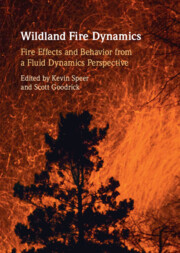Book contents
- Wildland Fire Dynamics
- Wildland Fire Dynamics
- Copyright page
- Contents
- Contributors
- 1 Wildland Fire Combustion Dynamics
- 2 The Structure of Line Fires at Flame Scale
- 3 Energy Transport and Measurements in Wildland and Prescribed Fires
- 4 Fire Line Geometry and Pyroconvective Dynamics
- 5 Firebrands
- 6 Re-envisioning Fire and Vegetation Feedbacks
- 7 Wind and Canopies
- 8 Coupled Fire–Atmosphere Model Evaluation and Challenges
- Index
- References
4 - Fire Line Geometry and Pyroconvective Dynamics
Published online by Cambridge University Press: 16 June 2022
- Wildland Fire Dynamics
- Wildland Fire Dynamics
- Copyright page
- Contents
- Contributors
- 1 Wildland Fire Combustion Dynamics
- 2 The Structure of Line Fires at Flame Scale
- 3 Energy Transport and Measurements in Wildland and Prescribed Fires
- 4 Fire Line Geometry and Pyroconvective Dynamics
- 5 Firebrands
- 6 Re-envisioning Fire and Vegetation Feedbacks
- 7 Wind and Canopies
- 8 Coupled Fire–Atmosphere Model Evaluation and Challenges
- Index
- References
Summary
This chapter presents a synopsis of some of the latest developments in our understanding of pyroconvective interactions, their links to fire geometrym and their role in driving dynamic fire behavior and extreme wildfire development. We highlight the need to augment traditional quasi-steady wildfire modeling paradigms with more sophisticated approaches that combine highly-instrumented, larger-scale experimental studies with state-of-the-art computational modeling. We identify the need to take maximum advantage of technical advances in remote sensing technology to provide new ways of observing extreme fire events.
- Type
- Chapter
- Information
- Wildland Fire DynamicsFire Effects and Behavior from a Fluid Dynamics Perspective, pp. 77 - 128Publisher: Cambridge University PressPrint publication year: 2022
References
- 2
- Cited by

